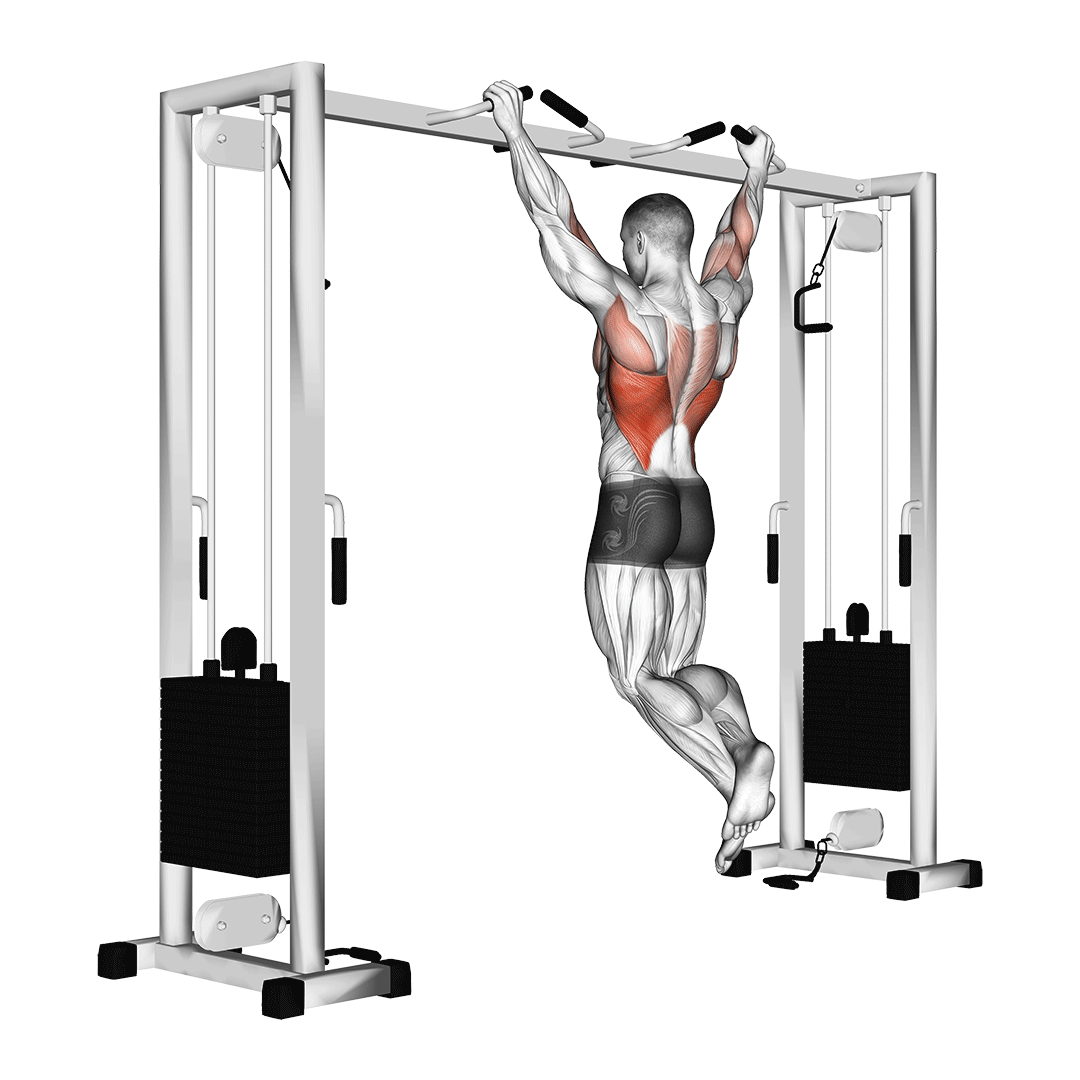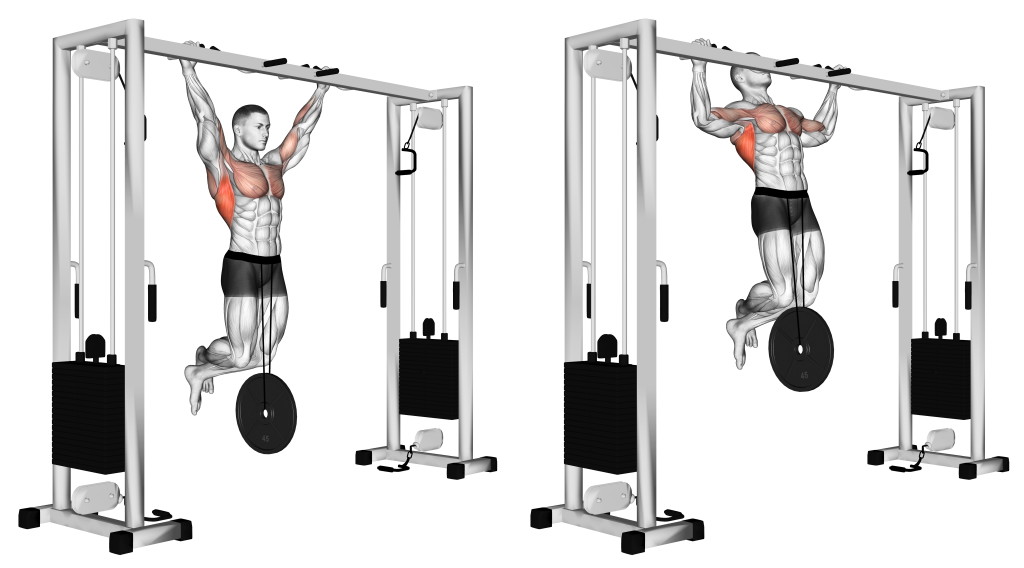Weighted Pull Up: Benefits, Muscles Worked, and More
Once a lifter has become sufficiently advanced enough to progress beyond the conventional pull-up, they can take two routes for continued progressive overload; performing time-consuming high volume sets, or switching to the weighted pull-up.
The latter choice is one that the majority of lifters pick, simply due to its greater efficiency and effectiveness at building strength in the muscles of the back.
The weighted pull-up is a progression from the standard pull-up that makes the addition of further resistance in the form of wearable weights or a belt and plate.
In practice, it is frequently used as the main compound exercise of a back workout, or as a secondary compound movement to maximize latissimus dorsi training stimuli.
What is the Weighted Pull-Up?
In more technical terms, the weighted pull-up is a closed kinetic chain free weight compound exercise of high intensity, usually performed in low-volume sets as a method of training the muscles of the back and arms.

The weighted pull-up is considered to be a direct progression from unweighted pull-ups, as it is quite difficult to perform weighted pull-ups without first being able to safely perform multiple repetitions of the conventional pull-up exercise.
Equipment Used for Loading the Weighted Pull-Up
The majority of weighted pull-up sets are performed with the use of a dip belt and a set of weight plates, though other calisthenic athletes may wish to use wearable weighted equipment or even simply grip a dumbbell between their feet.
Generally, lifters will wish to use equipment that allows for easily changeable amounts of weight to be added to the exercise, as well as one that will remain stable despite any momentum being translated from the exercise itself.
What is the Difference Between Weighted and Unweighted Pull-Ups?
As obvious as it may seem, the sole difference between the weighted and unweighted pull-up is the fact that additional resistance is used.

However, depending on the sort of equipment and angle of resistance involved, this may require small changes be made in the form of the weighted pull-up - especially in regards to core contraction, which may need to be intensified so as to avoid swinging due to additional weight added to the legs or pelvis.
As such, it is a good idea to begin performing weighted pull-ups with a small amount of additional weight at first, so as to make adjustments to the exercise’s form as needed.
How is the Weighted Pull-Up Performed?
To perform a repetition of the weighted pull-up, the lifter will simply perform the pull-up as normal, making small adjustments for the added equipment.
However, for posterity, we will go over the main form cues involved in any pull-up repetition, regardless of whether it is weighted or not.
Placing the hands wider than shoulder-width apart along a pull-up bar, the exerciser will face their head upwards and contract their core.
With this stance, they will draw themselves upwards by contracting the latissimus dorsi and pulling the elbows behind the back, stopping once their head has cleared the bar.
Then, they will return to the starting stance in a slow and controlled manner, ensuring that no swinging takes place whatsoever.
At this point, the repetition is now complete.
What Muscles are Worked by the Weighted Pull-Up?
As a compound movement, all variations of the pull-up exercise are capable of training numerous muscle groups simultaneously.

While the weighted pull-up does not train any new muscle groups in comparison to other pull-up variations, it does indeed make greater use of stabilizer muscle groups due to the increased demand for control over the additional weight.
Primary Mover Muscles
Weighted pull-ups will recruit the muscles of the latissimus dorsi, biceps brachii, trapezius, deltoid muscles and rhomboids to great effect - essentially training the entire upper and middle back alongside the majority of the arms in a single motion.
Accessory/Secondary Muscles
The weighted pull-up will also work other muscle groups to a lesser extent than the primary mover muscles, often in an isometric capacity so as to stabilize the movement and help maximize primary mover muscle work output.
These are primarily the pectoral muscles and those of the core, though other muscle groups like the erector spinae and brachioradialis are also utilized during specific portions of the movement pattern.
Benefits of Performing the Weighted Pull-Up
The reason many lifters will pick the weighted pull-up over other back exercises is quite simple; its benefits are highly pronounced, and quite easily achieved.
Greater Strength and Muscle Mass Development
In essence, the weighted pull-up can be considered a "souped-up" conventional pull-up in terms of potential as a training tool.
When supported with proper recovery and diet, performing the weighted pull-up can induce just as much physical development as other popular back exercises, such as the barbell row or deadlift.
In certain clinical cases, the weighted pull-up has been established as a better latissimus dorsi activator than practically all other exercises.
As such, there is no doubt that adding a weighted pull-up to your training plan will help break through plateaus and accelerate your back muscle growth.
Vastly Improved Forearm Strength
Considering the fact that all pull-up variations feature the lifter supporting their entire body weight through the muscles of their forearms alone, it should be no surprise that adding even further resistance to the exercise will increase the stress placed on the forearms as well.
While this stimulus is nonetheless isometric or stabilizing in nature, strength adaptations and subsequent hypertrophy are still very possible - and likely needed, as many modern training programs do not feature sufficient forearm training.
Improved Abdominal Muscle Endurance
While the conventional unweighted pull-up is not a very effective abdominal muscle training tool, the weighted pull-up requires far greater control of the lifter’s momentum due to the additional weight being an external object that is separate from the body.
As such, many lifters will find that with repeated performance, the weighted pull-up can provide a moderate amount of improvement in the functionality and muscular endurance of the core muscles - especially those of the abs, which will likely bear the brunt of the role.
Excellent Athletic and Lift Carryover
The conventional pull-up is featured in many athletic programs because it fits perfectly within the needs of most athletes; low impact, excellent for building endurance, widely accessible and is quite effective as a functional strength builder as well.
These factors are all the more present for the weighted variation of the pull-up, which will further improve muscular endurance and rate of force production in all recruited muscle groups.
For climbers or calisthenic athletes, there are few exercises as effective at improving their competitive edge as the weighted pull-up.
Common Mistakes of the Weighted Pull-Up
Despite the fact that the weighted pull-up is considered to be a more advanced exercise, some lifters may still be following poor habits that they carry over from their unweighted pull-up sets.
These errors in execution are all the more dangerous with the weighted pull-up, as the addition of further resistance can increase the risk of injury - requiring that such errors be corrected as soon as possible.
Swinging or “Kipping” Repetitions
Perhaps the most egregious mistake made when performing a weighted pull-up is utilizing excessive momentum.
Whether it be during the descending or ascending portion of the repetition, it is important to avoid any swinging as much as possible.
Kipping or dropping from the apex of the repetition too quickly can easily damage the rotator cuff of the shoulder, not to mention the increased risk of losing one’s grip on the bar.
Not only does this present a greatly increased risk of injury, but it will also decrease the involvement of all muscles, thereby reducing any benefit received from the exercise as well.
Hands Set Too Close or Too Far
Pull-ups (regardless of whether they are weighted or not) are a balancing act when it comes to hand placement.
Placing the hands parallel to the shoulders will shift much of the resistance to the forearms and produce a disadvantageous arm position, whereas arms that are too far apart will shift the resistance to the latissimus dorsi and create a far more difficult exercise.
While every lifter has their own unique body proportions, a good general tip is to place the hands a handbreadth away from shoulder width apart, creating enough distance to avoid injury while ensuring that the muscles of the arms and shoulders are able to exert force properly.
Poor Range of Motion
Like all exercises, going through the full range of motion is vitally important for maximizing the benefits of the weighted pull-up.
A common mistake made by lifters is not returning the arms to a state of full extension at the end of a repetition, leading to a reduced utilization of the latissimus dorsi and trapezius muscles.
On the opposite end, another frequently encountered mistake is lifters failing to pull themselves high enough.
To correct these issues, the lifter should focus on performing full repetitions in a slow manner, ensuring that the bar is beneath their head prior to beginning the descending portion, and then ensuring that they have come to a full stop with the arms fully extended overhead when ending a repetition.
Using Excessive Weight
During a set of weighted pull-ups, the lifter is not only moving the weighted equipment alone - they are also moving the entirety of their own body weight alongside it.
This factor is often overlooked by eager individuals who have just begun performing the weighted pull-up, leading them to load more weight than is reasonable and thereby increase their risk of injury.
If it is your first time performing a weighted pull-up, it is best to stick with a very low amount of weight and to keep the rate of perceived exertion between the ranges of 6 and 9, as adding excessive weight too quickly can lead to injury and fatigue.
Frequently Asked Questions (FAQ)
Are Weighted Pull-Ups Effective?
Yes - weighted pull-ups are among the most effective exercises for developing size and strength in the muscles of the upper body. So much so, in fact, that they are considered essential in many athletic or hybrid calisthenic training programs.
To make the most of weighted pull-ups, ensure that they are programmed properly, and that your diet and recovery methods are optimized as needed.
Do Weighted Pull-Ups Increase Regular Pull-Up Reps?
Yes, weighted pull-ups have the secondary effect of improving unweighted pull-up performance.
This is because of the greater potential for progressive overload that comes with weighted pull-ups, as well as the specificity of the training stimulus produced therein.
For calisthenic athletes who have plateaued in the number of pull-ups they are capable of performing, switching to weighted pull-ups for a time may aid in achieving their goals.
How Often Should I Do Weighted Pull-Ups?
Like most resistance exercises, recovery between workouts involving the weighted pull-up is essential for maintaining progression and physiological health.
At most (unless following a specific training program), it is best to only perform weighted pull-ups for up to 3 times per week, with at least one day of rest in between training sessions. Keep in mind that other exercises that train the back and biceps can still interrupt your recovery.
In Conclusion
If you’re still not sure of whether you should switch to weighted pull-ups or not, try aiming for at least 8-10 repetitions consecutively, as this should help provide the foundation for being able to perform weighted pull-up repetitions safely.
References
1. Sas-Nowosielski, Krzysztof. (2018). The acute effects of weighted pull-ups on campus board power and power endurance exercises.
2. Johnson, Doug & Lynch, James & Nash, Kedren & Cygan, Joe & Mayhew, Jerry. (2009). Relationship of Lat-Pull Repetitions and Pull-Ups to Maximal Lat-Pull and Pull-Up Strength in Men and Women. Journal of strength and conditioning research / National Strength & Conditioning Association. 23. 1022-8. 10.1519/JSC.0b013e3181a2d7f5.
